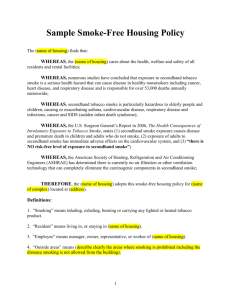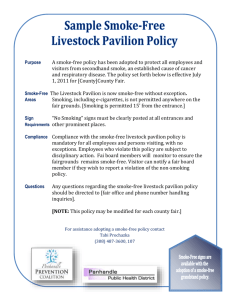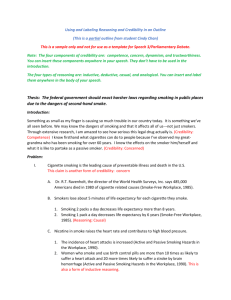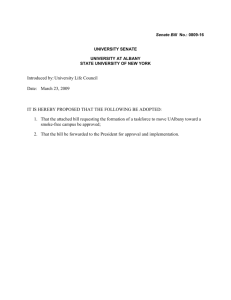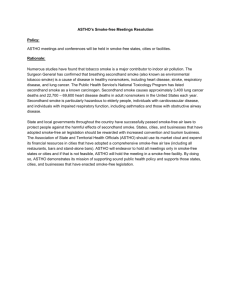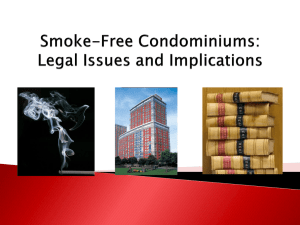Dear MTCP-funded BOH and Community Partnership programs,
advertisement
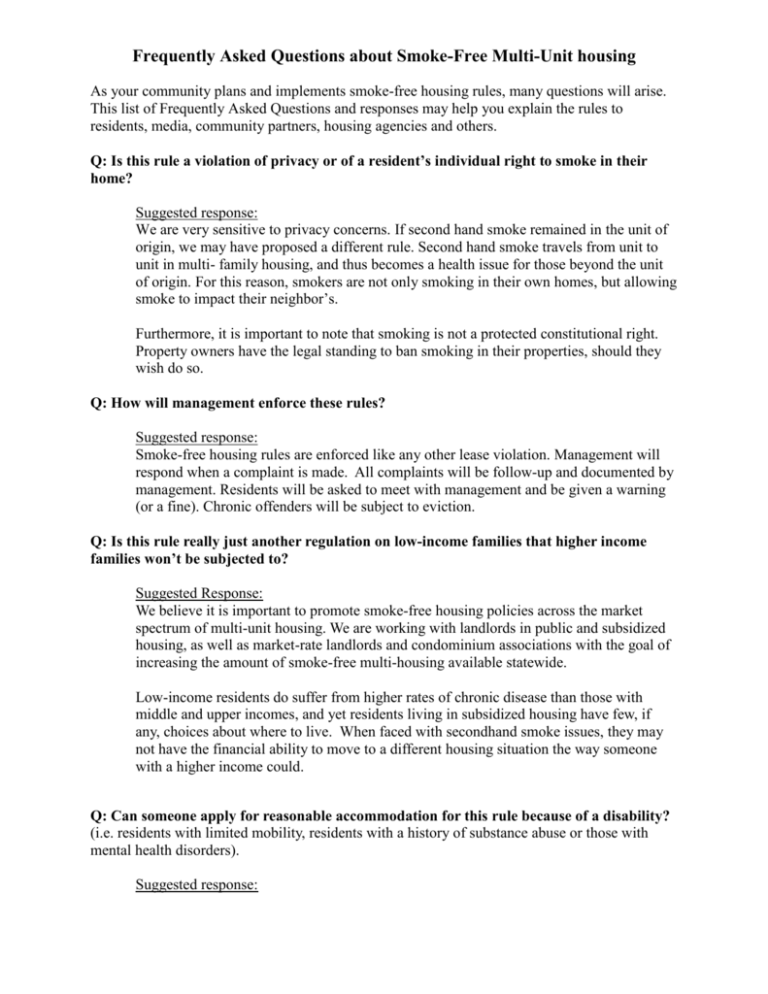
Frequently Asked Questions about Smoke-Free Multi-Unit housing As your community plans and implements smoke-free housing rules, many questions will arise. This list of Frequently Asked Questions and responses may help you explain the rules to residents, media, community partners, housing agencies and others. Q: Is this rule a violation of privacy or of a resident’s individual right to smoke in their home? Suggested response: We are very sensitive to privacy concerns. If second hand smoke remained in the unit of origin, we may have proposed a different rule. Second hand smoke travels from unit to unit in multi- family housing, and thus becomes a health issue for those beyond the unit of origin. For this reason, smokers are not only smoking in their own homes, but allowing smoke to impact their neighbor’s. Furthermore, it is important to note that smoking is not a protected constitutional right. Property owners have the legal standing to ban smoking in their properties, should they wish do so. Q: How will management enforce these rules? Suggested response: Smoke-free housing rules are enforced like any other lease violation. Management will respond when a complaint is made. All complaints will be follow-up and documented by management. Residents will be asked to meet with management and be given a warning (or a fine). Chronic offenders will be subject to eviction. Q: Is this rule really just another regulation on low-income families that higher income families won’t be subjected to? Suggested Response: We believe it is important to promote smoke-free housing policies across the market spectrum of multi-unit housing. We are working with landlords in public and subsidized housing, as well as market-rate landlords and condominium associations with the goal of increasing the amount of smoke-free multi-housing available statewide. Low-income residents do suffer from higher rates of chronic disease than those with middle and upper incomes, and yet residents living in subsidized housing have few, if any, choices about where to live. When faced with secondhand smoke issues, they may not have the financial ability to move to a different housing situation the way someone with a higher income could. Q: Can someone apply for reasonable accommodation for this rule because of a disability? (i.e. residents with limited mobility, residents with a history of substance abuse or those with mental health disorders). Suggested response: Because addiction to nicotine is not a qualifying disability under state or federal law, there is no legal requirement to allow someone to smoke in his or her apartment. As such, there will be no exceptions that will allow residents to smoke indoors. If there were, it would fundamentally alter the intent of the rule. However, we take all accommodation requests seriously and review them on a case-by-case basis. There may be accommodations made based on disabilities that might assist residents in complying with the rule (i.e. moving a resident to a 1st floor unit or closer to an exit to make it easier to get outside to smoke). Q: Do you recommend installing a designated smoking area on the property outside the building? Suggested response: There are many reasons not to install a covered smoking area on the property outside the building. From a management perspective, they can be costly to install and burdensome to maintain. In poor weather and dark conditions, management must ensure there is a safe pathway to the shelter. Management would also be expected to clean the shelter regularly. Additionally, in marketing to potential residents, banning smoking on all grounds will allow owners to advertise a smoke-free property, not just a smoke-free building. Survey data shows high preferences for smoke-free properties among Massachusetts residents. Finally, from a health perspective, completely removing smoke from the property helps to change social norms around smoking, removing a trigger for people who have quit smoking and serving as a motivation for others to make a quit attempt. Q: What is the standard perimeter around a building that should be included in the smokefree rules? Suggested response: There is no correct answer to this question because each property is different. Some properties have large campuses and others abut a city sidewalk. If possible, a minimum of a 15-20 foot perimeter is recommended around the building so that smoke does not waft into open windows or concentrate around entryways. However, this is not always possible. It is best to examine each property individually before writing a rule. From a public health perspective, it is best to remove smoking from the property entirely. Q: Can the landlord prohibit the smoking of medical marijuana in a no-smoking policy? Suggested response: Yes. The language of the Massachusetts medical marijuana law, as well as the Department of Public Health’s regulations implementing the law, specifically state that nothing in the law or regulations limits the applicability of other laws. Therefore, because landlords are permitted to prohibit smoking in general in their properties, they are likewise permitted to prohibit the smoking of marijuana, for medical purposes or otherwise, in its properties. Federal law that governs reasonable accommodations in housing for people with disabilities precludes “ongoing illegal drug use.” Marijuana is still an illegal Schedule I drug under the Controlled Substance Act, which means that its use need not be accommodated, even if the tenant is certified to use it for medical purposes under state law. Q: Do you recommend grandfathering? Suggested response: We do not recommend grandfathering. The properties we have worked with that have decided to grandfather existing residents tend to be condominiums where a person owns their unit. Many condominiums, however, do not grandfather. Grandfathering is challenging because enforcing the rule can be very difficult if the policy applies to some units and not others. People who have complained about drifting smoke often feel as if their needs aren’t being addressed because there is still smoke in the building. Grandfathering may delay the health and safety benefits of a smoke-free policy by many years. Q: Do you recommend making all our properties/building smoke-free at once, or phasing in the policy? Suggested response: This depends on the landlord and the properties. For very large management companies with sites across multiple cities or states, it might make sense to implement the policy in some buildings but not all. This might allow time for the management to learn how to best implement and enforce the policy. Smaller landlords and public housing authorities that are managing properties within a few sites should implement the policy across all properties at once so as not to create uneven treatment for residents. Implementation all at once may also be easier from a management perspective because residents won’t be asking to transfer to or from a specific building based on the rule.


